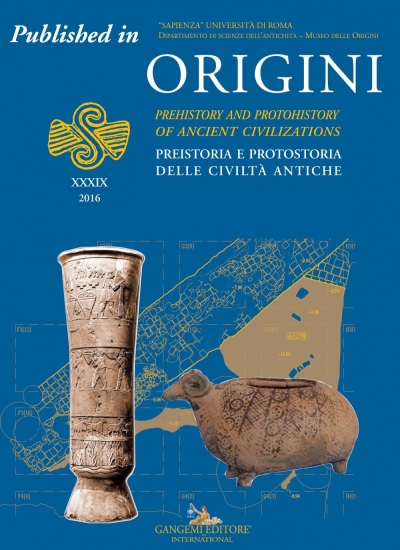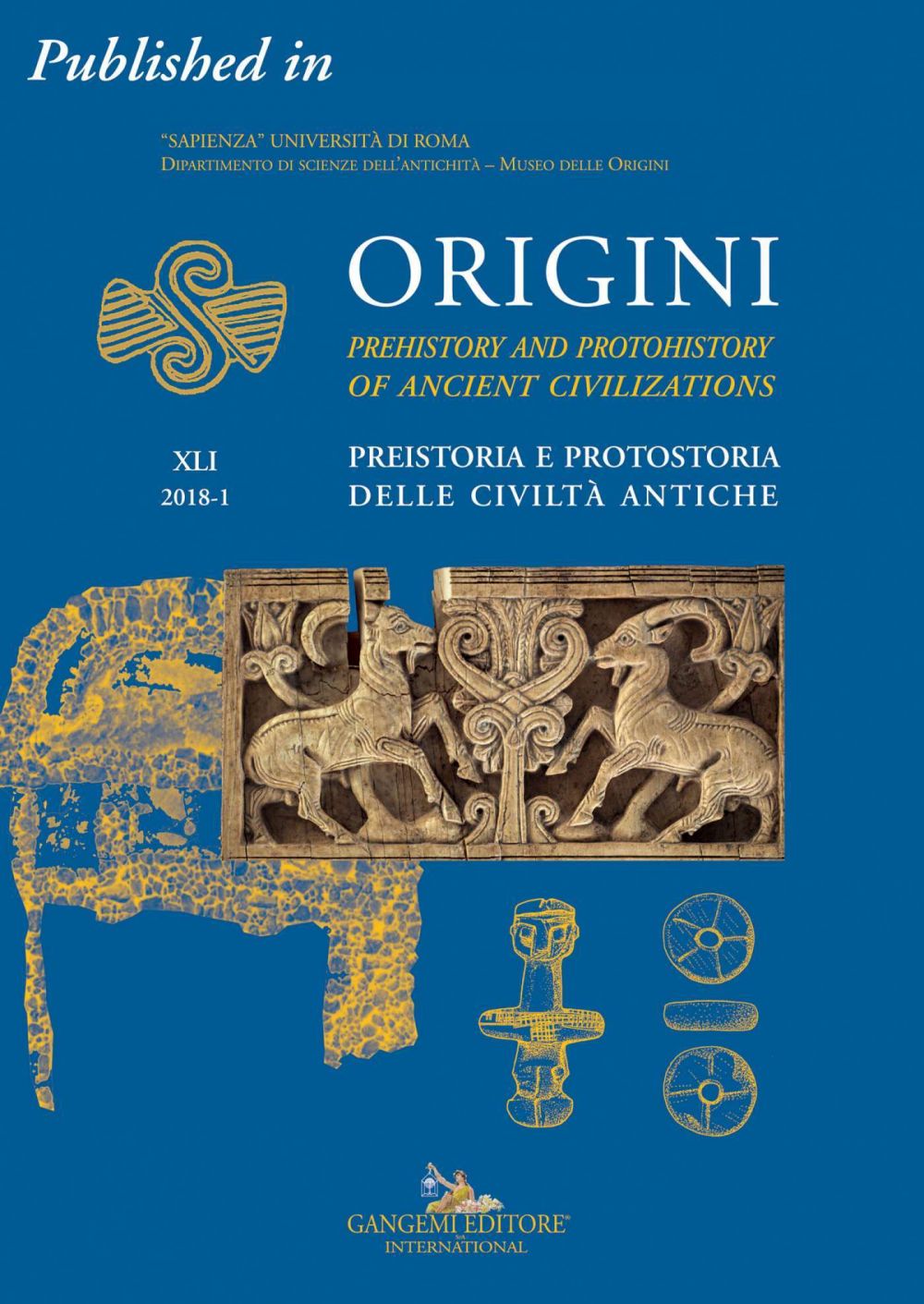A “Flame and Frond” ivory plaque from the Neo-Hittite excavations at Arslantepe/Melid. Regionalisms and communities in Iron Age Anatolia
Published in Origini n. XLI/2018. Rivista annuale del Dipartimento di Scienze dell’Antichità – “Sapienza” Università di Roma | Preistoria e protostoria delle civiltà antiche – Prehistory and protohistory of ancient civilizations
Autore:
Editore:
Anno:
2019
ISBN:
9788849243796
DRM:
Adobe (The downloaded file has the .acsm extension and is converted into the purchased format upon installation on your eReader)
Autore:
Editore:
Anno:
2019
ISBN:
9788849243796
DRM:
Adobe (The downloaded file has the .acsm extension and is converted into the purchased format upon installation on your eReader)
Description
This paper presents a new outstanding discovery from 2016 at the site of Arslantepe (Malatya, SE Turkey), a finely made ivory plaque found in an Iron Age context approximately dated at the beginning of the 8th century BCE. The object belongs to the well-known “Flame and Frond” ivory carving school and its discovery at Arslantepe suggests intriguing cross-cultural relationships with the Levantine and northern Mesopotamian worlds. The article describes and discusses the new find within the corpus of the 1st millennium BCE Near Eastern production of ivory and luxury goods. It aims at evaluating innovative aspects of intercultural communication as well as the legacy of ancient traditions in the formation of the new artistic trends at Arslantepe and within the flourishing of the Iron Age societies. | L’articolo presenta una nuova ed importante scoperta avvenuta nel 2016 nel sito di Arslantepe (Malatya, Turchia SO). Si tratta di una placchetta d’avorio finemente realizzata e proveniente da un contesto dell’Età del Ferro, datato grossomodo all’inizio del VIII secolo a.C. L’oggetto appartiene alla famosa scuola eburnea denominata “Flame and Frond”, e la sua presenza ad Arslantepe suggerisce affascinanti relazioni culturali con il Levante e la Mesopotamia settentrionale. L’articolo descrive e discute il nuovo ritrovamento nel contesto degli avori e degli oggetti di lusso vicino orientali del I millennio a.C. L’obiettivo è di esaminare gli aspetti innovativi di scambio interculturale così come il retaggio lasciato dalle più antiche tradizioni nella formazione delle nuove tendenze artistiche ad Arslantepe e nell’ambito dell’evoluzione delle rigogliose società dell’Età del Ferro.
Tags
By the same author
ORIGINI - XLI
Preistoria e Protostoria delle Civiltà Antiche - Prehistory and Protohistory of Ancient Civilizations
Preistoria e Protostoria delle Civiltà Antiche - Prehistory and Protohistory of Ancient Civilizations
29.99 €
39
-41
 ORIGINI - XLI
Preistoria e Protostoria delle Civiltà Antiche - Prehistory and Protohistory of Ancient Civilizations
ORIGINI - XLI
Preistoria e Protostoria delle Civiltà Antiche - Prehistory and Protohistory of Ancient Civilizations
Marcella Frangipane, Gangemi Editore
 ORIGINI - XLI
Preistoria e Protostoria delle Civiltà Antiche - Prehistory and Protohistory of Ancient Civilizations
ORIGINI - XLI
Preistoria e Protostoria delle Civiltà Antiche - Prehistory and Protohistory of Ancient CivilizationsMarcella Frangipane, Gangemi Editore
29,99 €
A “FLAME AND FROND” IVORY PLAQUE FROM THE NEO-HITTITE EXCAVATIONS AT ARSLANTEPE/MELID. REGIONALISMS AND COMMUNITIES IN IRON AGE ANATOLIA
Published in Origini n. XLI/2018. Rivista annuale del Dipartimento di Scienze dell’Antichità – “Sapienza” Università di Roma | Preistoria e protostoria delle civiltà antiche – Prehistory and protohistory of ancient civilizations
Published in Origini n. XLI/2018. Rivista annuale del Dipartimento di Scienze dell’Antichità – “Sapienza” Università di Roma | Preistoria e protostoria delle civiltà antiche – Prehistory and protohistory of ancient civilizations
6.99 €
39
-41
 A “FLAME AND FROND” IVORY PLAQUE FROM THE NEO-HITTITE EXCAVATIONS AT ARSLANTEPE/MELID. REGIONALISMS AND COMMUNITIES IN IRON AGE ANATOLIA
Published in Origini n. XLI/2018. Rivista annuale del Dipartimento di Scienze dell’Antichità – “Sapienza” Università di Roma | Preistoria e protostoria delle civiltà antiche – Prehistory and protohistory of ancient civilizations
A “FLAME AND FROND” IVORY PLAQUE FROM THE NEO-HITTITE EXCAVATIONS AT ARSLANTEPE/MELID. REGIONALISMS AND COMMUNITIES IN IRON AGE ANATOLIA
Published in Origini n. XLI/2018. Rivista annuale del Dipartimento di Scienze dell’Antichità – “Sapienza” Università di Roma | Preistoria e protostoria delle civiltà antiche – Prehistory and protohistory of ancient civilizations
Federico Manuelli, Gangemi Editore
 A “FLAME AND FROND” IVORY PLAQUE FROM THE NEO-HITTITE EXCAVATIONS AT ARSLANTEPE/MELID. REGIONALISMS AND COMMUNITIES IN IRON AGE ANATOLIA
Published in Origini n. XLI/2018. Rivista annuale del Dipartimento di Scienze dell’Antichità – “Sapienza” Università di Roma | Preistoria e protostoria delle civiltà antiche – Prehistory and protohistory of ancient civilizations
A “FLAME AND FROND” IVORY PLAQUE FROM THE NEO-HITTITE EXCAVATIONS AT ARSLANTEPE/MELID. REGIONALISMS AND COMMUNITIES IN IRON AGE ANATOLIA
Published in Origini n. XLI/2018. Rivista annuale del Dipartimento di Scienze dell’Antichità – “Sapienza” Università di Roma | Preistoria e protostoria delle civiltà antiche – Prehistory and protohistory of ancient civilizationsFederico Manuelli, Gangemi Editore
6,99 €
ORIGINI - XXXIX
Preistoria e protostoria delle civiltà antiche - Prehistory and protohistory of ancient civilizations
Preistoria e protostoria delle civiltà antiche - Prehistory and protohistory of ancient civilizations
Marcella Frangipane,
Giorgia Agresti,
Silvia Alaura,
Ebru Albayrak,
Mario Amore,
Magda Bordigoni,
Filippo Bozzo,
Giorgio Brocato,
Isabella Caneva,
Patrizia Costa,
Gian Maria Di Nocera,
Emilia Gallo,
Philip Jones,
Coskun Köysu,
Cristina Lemorini,
Federico Manuelli,
Francesco Marano,
Azzurra Mascelloni,
Naomi F. Miller,
Federico Moresi,
Lucia Mori,
Davide Nadali,
Marco Pacciarelli,
Fabio Parenti,
Giancarlo Pastura,
Claudia Pelosi,
Holly Pittman,
Elena Pizzo,
Andrea Polcaro,
Fabio Rossi,
Ulderico Santamaria,
Antonio Tagliacozzo,
Halil Tekin,
Flavia Venditti,
Daniela Zampetti,
Nadine Mine Yar
29.99 €
39
-41
 ORIGINI - XXXIX
Preistoria e protostoria delle civiltà antiche - Prehistory and protohistory of ancient civilizations
ORIGINI - XXXIX
Preistoria e protostoria delle civiltà antiche - Prehistory and protohistory of ancient civilizations
Marcella Frangipane, Gangemi Editore
 ORIGINI - XXXIX
Preistoria e protostoria delle civiltà antiche - Prehistory and protohistory of ancient civilizations
ORIGINI - XXXIX
Preistoria e protostoria delle civiltà antiche - Prehistory and protohistory of ancient civilizationsMarcella Frangipane, Gangemi Editore
29,99 €
“THE KING AT THE GATE”. MONUMENTAL FORTIFICATIONS AND THE RISE OF LOCAL ELITES AT ARSLANTEPE AT THE END OF THE 2ND MILLENNIUM
Published in Origini n. XXXIX/2016. Rivista annuale del Dipartimento di Scienze dell’Antichità – “Sapienza” Università di Roma | Preistoria e protostoria delle civiltà antiche – Prehistory and protohistory of ancient civilizations
Published in Origini n. XXXIX/2016. Rivista annuale del Dipartimento di Scienze dell’Antichità – “Sapienza” Università di Roma | Preistoria e protostoria delle civiltà antiche – Prehistory and protohistory of ancient civilizations
6.99 €
39
-41
 “THE KING AT THE GATE”. MONUMENTAL FORTIFICATIONS AND THE RISE OF LOCAL ELITES AT ARSLANTEPE AT THE END OF THE 2ND MILLENNIUM
Published in Origini n. XXXIX/2016. Rivista annuale del Dipartimento di Scienze dell’Antichità – “Sapienza” Università di Roma | Preistoria e protostoria delle civiltà antiche – Prehistory and protohistory of ancient civilizations
“THE KING AT THE GATE”. MONUMENTAL FORTIFICATIONS AND THE RISE OF LOCAL ELITES AT ARSLANTEPE AT THE END OF THE 2ND MILLENNIUM
Published in Origini n. XXXIX/2016. Rivista annuale del Dipartimento di Scienze dell’Antichità – “Sapienza” Università di Roma | Preistoria e protostoria delle civiltà antiche – Prehistory and protohistory of ancient civilizations
Federico Manuelli, Gangemi Editore
 “THE KING AT THE GATE”. MONUMENTAL FORTIFICATIONS AND THE RISE OF LOCAL ELITES AT ARSLANTEPE AT THE END OF THE 2ND MILLENNIUM
Published in Origini n. XXXIX/2016. Rivista annuale del Dipartimento di Scienze dell’Antichità – “Sapienza” Università di Roma | Preistoria e protostoria delle civiltà antiche – Prehistory and protohistory of ancient civilizations
“THE KING AT THE GATE”. MONUMENTAL FORTIFICATIONS AND THE RISE OF LOCAL ELITES AT ARSLANTEPE AT THE END OF THE 2ND MILLENNIUM
Published in Origini n. XXXIX/2016. Rivista annuale del Dipartimento di Scienze dell’Antichità – “Sapienza” Università di Roma | Preistoria e protostoria delle civiltà antiche – Prehistory and protohistory of ancient civilizationsFederico Manuelli, Gangemi Editore
6,99 €
ORIGINI - XLI
Preistoria e Protostoria delle Civiltà Antiche - Prehistory and Protohistory of Ancient Civilizations
Preistoria e Protostoria delle Civiltà Antiche - Prehistory and Protohistory of Ancient Civilizations
29.99 €
39
-41
 ORIGINI - XLI
Preistoria e Protostoria delle Civiltà Antiche - Prehistory and Protohistory of Ancient Civilizations
ORIGINI - XLI
Preistoria e Protostoria delle Civiltà Antiche - Prehistory and Protohistory of Ancient Civilizations
Marcella Frangipane, Gangemi Editore
 ORIGINI - XLI
Preistoria e Protostoria delle Civiltà Antiche - Prehistory and Protohistory of Ancient Civilizations
ORIGINI - XLI
Preistoria e Protostoria delle Civiltà Antiche - Prehistory and Protohistory of Ancient CivilizationsMarcella Frangipane, Gangemi Editore
29,99 €
A “FLAME AND FROND” IVORY PLAQUE FROM THE NEO-HITTITE EXCAVATIONS AT ARSLANTEPE/MELID. REGIONALISMS AND COMMUNITIES IN IRON AGE ANATOLIA
Published in Origini n. XLI/2018. Rivista annuale del Dipartimento di Scienze dell’Antichità – “Sapienza” Università di Roma | Preistoria e protostoria delle civiltà antiche – Prehistory and protohistory of ancient civilizations
Published in Origini n. XLI/2018. Rivista annuale del Dipartimento di Scienze dell’Antichità – “Sapienza” Università di Roma | Preistoria e protostoria delle civiltà antiche – Prehistory and protohistory of ancient civilizations
6.99 €
39
-41
 A “FLAME AND FROND” IVORY PLAQUE FROM THE NEO-HITTITE EXCAVATIONS AT ARSLANTEPE/MELID. REGIONALISMS AND COMMUNITIES IN IRON AGE ANATOLIA
Published in Origini n. XLI/2018. Rivista annuale del Dipartimento di Scienze dell’Antichità – “Sapienza” Università di Roma | Preistoria e protostoria delle civiltà antiche – Prehistory and protohistory of ancient civilizations
A “FLAME AND FROND” IVORY PLAQUE FROM THE NEO-HITTITE EXCAVATIONS AT ARSLANTEPE/MELID. REGIONALISMS AND COMMUNITIES IN IRON AGE ANATOLIA
Published in Origini n. XLI/2018. Rivista annuale del Dipartimento di Scienze dell’Antichità – “Sapienza” Università di Roma | Preistoria e protostoria delle civiltà antiche – Prehistory and protohistory of ancient civilizations
Federico Manuelli, Gangemi Editore
 A “FLAME AND FROND” IVORY PLAQUE FROM THE NEO-HITTITE EXCAVATIONS AT ARSLANTEPE/MELID. REGIONALISMS AND COMMUNITIES IN IRON AGE ANATOLIA
Published in Origini n. XLI/2018. Rivista annuale del Dipartimento di Scienze dell’Antichità – “Sapienza” Università di Roma | Preistoria e protostoria delle civiltà antiche – Prehistory and protohistory of ancient civilizations
A “FLAME AND FROND” IVORY PLAQUE FROM THE NEO-HITTITE EXCAVATIONS AT ARSLANTEPE/MELID. REGIONALISMS AND COMMUNITIES IN IRON AGE ANATOLIA
Published in Origini n. XLI/2018. Rivista annuale del Dipartimento di Scienze dell’Antichità – “Sapienza” Università di Roma | Preistoria e protostoria delle civiltà antiche – Prehistory and protohistory of ancient civilizationsFederico Manuelli, Gangemi Editore
6,99 €
ORIGINI - XXXIX
Preistoria e protostoria delle civiltà antiche - Prehistory and protohistory of ancient civilizations
Preistoria e protostoria delle civiltà antiche - Prehistory and protohistory of ancient civilizations
Marcella Frangipane,
Giorgia Agresti,
Silvia Alaura,
Ebru Albayrak,
Mario Amore,
Magda Bordigoni,
Filippo Bozzo,
Giorgio Brocato,
Isabella Caneva,
Patrizia Costa,
Gian Maria Di Nocera,
Emilia Gallo,
Philip Jones,
Coskun Köysu,
Cristina Lemorini,
Federico Manuelli,
Francesco Marano,
Azzurra Mascelloni,
Naomi F. Miller,
Federico Moresi,
Lucia Mori,
Davide Nadali,
Marco Pacciarelli,
Fabio Parenti,
Giancarlo Pastura,
Claudia Pelosi,
Holly Pittman,
Elena Pizzo,
Andrea Polcaro,
Fabio Rossi,
Ulderico Santamaria,
Antonio Tagliacozzo,
Halil Tekin,
Flavia Venditti,
Daniela Zampetti,
Nadine Mine Yar
29.99 €
39
-41
 ORIGINI - XXXIX
Preistoria e protostoria delle civiltà antiche - Prehistory and protohistory of ancient civilizations
ORIGINI - XXXIX
Preistoria e protostoria delle civiltà antiche - Prehistory and protohistory of ancient civilizations
Marcella Frangipane, Gangemi Editore
 ORIGINI - XXXIX
Preistoria e protostoria delle civiltà antiche - Prehistory and protohistory of ancient civilizations
ORIGINI - XXXIX
Preistoria e protostoria delle civiltà antiche - Prehistory and protohistory of ancient civilizationsMarcella Frangipane, Gangemi Editore
29,99 €
SIGN AND IMAGE: REPRESENTATIONS OF PLANTS ON THE WARKA VASE OF EARLY MESOPOTAMIA
Published in Origini n. XXXIX/2016. Rivista annuale del Dipartimento di Scienze dell’Antichità – “Sapienza” Università di Roma | Preistoria e protostoria delle civiltà antiche – Prehistory and protohistory of ancient civilizations
Published in Origini n. XXXIX/2016. Rivista annuale del Dipartimento di Scienze dell’Antichità – “Sapienza” Università di Roma | Preistoria e protostoria delle civiltà antiche – Prehistory and protohistory of ancient civilizations
6.99 €
39
-41
 SIGN AND IMAGE: REPRESENTATIONS OF PLANTS ON THE WARKA VASE OF EARLY MESOPOTAMIA
Published in Origini n. XXXIX/2016. Rivista annuale del Dipartimento di Scienze dell’Antichità – “Sapienza” Università di Roma | Preistoria e protostoria delle civiltà antiche – Prehistory and protohistory of ancient civilizations
SIGN AND IMAGE: REPRESENTATIONS OF PLANTS ON THE WARKA VASE OF EARLY MESOPOTAMIA
Published in Origini n. XXXIX/2016. Rivista annuale del Dipartimento di Scienze dell’Antichità – “Sapienza” Università di Roma | Preistoria e protostoria delle civiltà antiche – Prehistory and protohistory of ancient civilizations
Philip Jones, Gangemi Editore
 SIGN AND IMAGE: REPRESENTATIONS OF PLANTS ON THE WARKA VASE OF EARLY MESOPOTAMIA
Published in Origini n. XXXIX/2016. Rivista annuale del Dipartimento di Scienze dell’Antichità – “Sapienza” Università di Roma | Preistoria e protostoria delle civiltà antiche – Prehistory and protohistory of ancient civilizations
SIGN AND IMAGE: REPRESENTATIONS OF PLANTS ON THE WARKA VASE OF EARLY MESOPOTAMIA
Published in Origini n. XXXIX/2016. Rivista annuale del Dipartimento di Scienze dell’Antichità – “Sapienza” Università di Roma | Preistoria e protostoria delle civiltà antiche – Prehistory and protohistory of ancient civilizationsPhilip Jones, Gangemi Editore
6,99 €


